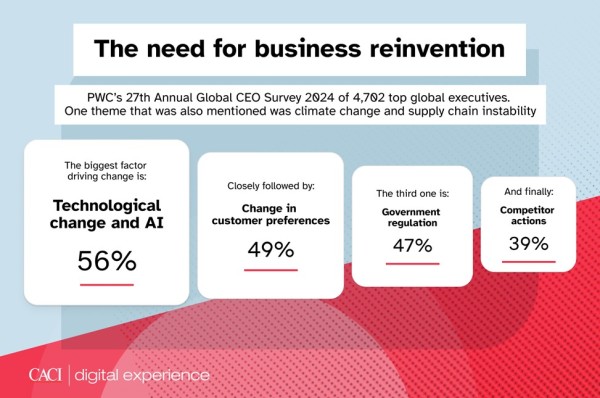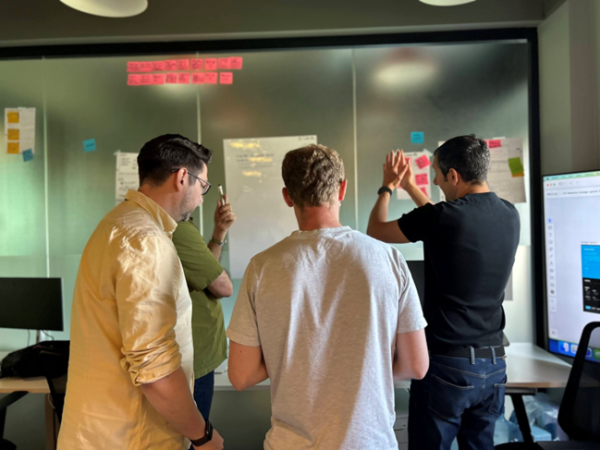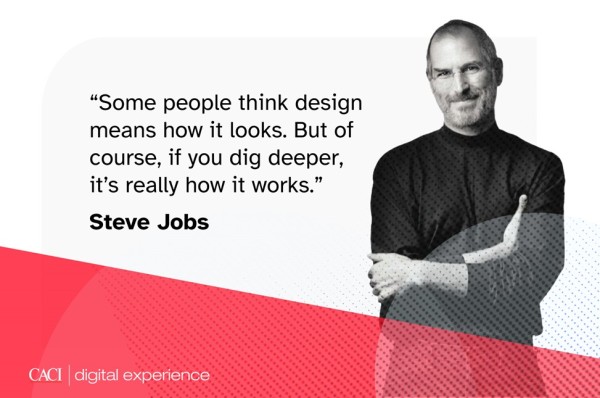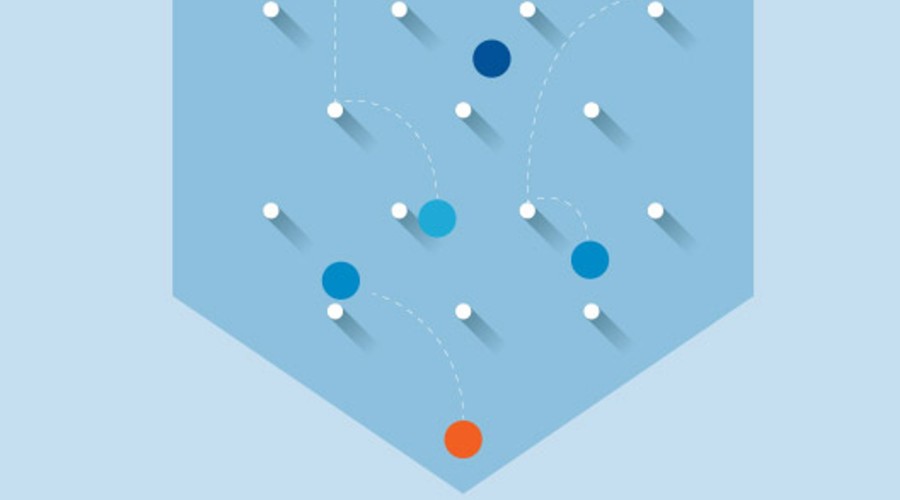“Standing still is the fastest way of moving backwards in a rapidly changing world”. Attributed to legendary Hollywood actress Lauren Bacall, never has a quote seemed more relevant today. So, what are businesses' biggest strategic challenges and needs for transformation, and how can Service Design help solve them?
Businesses must change, fast, or die.
It might sound dramatic, but that’s the view from PWC’s 27th Annual Global CEO Survey 2024 of 4,702 top global executives.
Nearly half those surveyed believed their companies would no longer be viable in ten years’ time if they continued on their current path. Up from 4 in 10 a year ago.
What's behind the need for rapid business reinvention?
It will come as no surprise the CEOs surveyed felt the single biggest factor driving change is technological change including AI (56%). Closely followed by change in customer preferences (49%) and government regulation (47%) and competitor actions (38%) with climate change and supply chain instability also featuring.

To tackle these ‘megatrends’, leaders must re-evaluate longstanding business, technology and operating models and address competing priorities. AI might deliver on improved customer experience (CX) and operational efficiency, but also has a massive carbon footprint, for example.
Because these challenges are dynamic and technology never stands still, there’s also no end point to the transformation required. This requires a culture of innovation that gives even the biggest businesses like Amazon the ability to adapt over time to drive revenue growth and business value.
This need for continual reinvention is an enormous challenge. One that Service Design can help tackle.
What is Service Design and why can it help with business change?
Service Design is a human-centred and evidence-led approach to creating and evolving services. The approach aligns people, processes, systems, technology and strategy to develop experiences that are valuable to organisations and their customers.
But if you’ve not heard of Service Design before, then you’re not alone.
Nearly 4 in 10 business leaders recently surveyed had no idea what it was. And of the 62% who did recognise the term, just 3% matched the broadly agreed definition. So, how can it help businesses with their need for reinvention?

Our interdisciplinary team of Service Designers hard at work during a design sprint
Pioneering Service Designer Marc Fonteijn explains it well:
“When you have two coffee shops next to each other, each selling the same coffee at the same price, service design is what makes you walk into one and not the other, come back often and tell your friends about it”.
Imagine the difference between pre-ordering via an app, arriving to be greeted warmly by name, the coffee ready, versus a café with a long queue to order and staff so focused on catching up, they barely say hello. The service experience (the 'front-stage'), a combination of behind-the-scenes business decisions including technology, processes, logistics, supplier contracts, employee training and more besides (the 'back-stage').
Service Design's interdisciplinary approach uses a variety of quantitative and qualitative research and business analysis to unpick how such services work in practice. And then (re)designs them to be enjoyable, efficient and add value to everyone who use them: customers, employees, suppliers and investors alike.
Because of its human-centred approach working collaboratively with stakeholders, Service Design not only discovers ‘what’ change needs to happen to functionally optimise the service, it also delivers solutions for ‘how’ the change can happen. The difference between ‘the business needs an app’ to ‘here are the changes we need to make to successfully implement an app’. Effectively bridging the gap between the strategy and execution.

Key barriers to business change and how Service Design can help overcome them
The CEOs surveyed by PWC felt that most barriers inhibiting their company from change were within their sphere of influence. While the single biggest factor cited (64%) was the external regulatory environment, the following factors were more internal: competing priorities (55%), lack of generalised skills (52%), limited financial resources (47%) and lack of technological skills (46%).
CEOs were concerned about efficiency across the board. On average saying that 40% of time spent on emails, meetings and processes (including procurement, hiring, expense, performance, payroll and technology) is inefficient. Many were looking towards AI for efficiency gains with 64% saying they thought it would drive efficiency but 7 in 10 stated that it would require most their workforce to develop new skills over the next three years.
Service Design’s holistic approach that breaks down all the technological, operational and human moving parts of the business can help tackle all these barriers and inefficiencies:
Achieving continual compliance
Identified as the biggest barrier to change, regulations and standards are rightly unavoidable. As part of the Service Design mapping process, it helps businesses audit and identify relevant regulations, weaving compliance into the fabric of service delivery.
An example might be in the Financial Services sector around anti-money laundering (AML) regulations. Service Designers will design the entire service geared towards continual compliance: from a digital onboarding process to ensure all required customer information is collected consistently, automated monitoring processes to detect suspicious transactions, centralised report dashboards for real-time compliance insights alongside a structured process for regularly updating employees on regulations.
Read about how we used Service Design to create a scalable customer journey framework for Handelsbanken to be compliant with the FCA’s Consumer Duty. The same approach can be taken to embed other regulatory requirements into services whether that’s carbon reporting or accessibility.
Building company capabilities and skillsets
Skills generally were flagged as a critical barrier. Service Design’s human-centred approach identifies various skills gaps as part of its work and as part of implementing any service develops the relevant progression frameworks to help upskill them. A particular pressing need in the case of AI. A critical part of our Service Design work is to empower business teams through digital academies and training programs to help them navigate the digital landscape effectively, which was also a critical part of our work with Handelsbanken.
Creating seamless, efficient processes and systems
The aim of our Service Design work is always to improve how services ‘flow’ to deliver value in a commercially viable way. Like with our example from with anti-money laundering regulation or the technology-enabled coffee shop, those services are also more efficient for everyone involved alongside delivering enhanced CX that’s associated with higher customer retention and increased revenue.
The Service Design process also identifies disparate digital tools, technologies, platforms and systems to deliver cost-efficiencies and streamlined experiences that work all service users. For business leaders hoping to use AI for efficiency gains, we’ve found from our work implementing AI for clients, that fragmented, incomplete data is a fundamental blocker preventing firms from adopting it effectively. Service Design helps overcome this issue through data audit, strategy and infrastructure design in line with business objectives and user needs.
Building a collaborative, innovative culture
While CEOs didn’t explicitly name this as a key barrier, as highlighted above, companies can only respond to dynamic change if their culture supports innovation and continual improvement. Service Design works in collaboration between diverse stakeholders, and designs in the continual integration of user feedback into service delivery, including after it’s implemented. This helps remove business silos, enhances communication and fosters an environment where experimentation is valued, and innovation can flourish.
How our Service Designers can help your business
At CACI, we apply our proven EDEN model to understand the service estate and service operating model from a holistic perspective.
We work with our clients to assemble a team, set the goals and create organisational alignment around the current state of the service using existing props, processes and people to identify the future aspirations and undertake successful change management with effective communication and collaboration at the heart of the transformation.
We design a unified vision of the service, test assumptions and iterate to implement design recommendations. We do this whilst taking a human-centric, evidence-based approach. We then move into the design of a better service and service operating model by blueprinting a future-state and defining how the 'front-stage' and 'back-stage' needs to change. Quite often, our team also helps clients to assess their capabilities and digital maturity from the outset to empower, train and upskill the organisation during the navigation and post completion stages.
If you’d like to find out how our Service Design experts can help empower your business and people to adapt to an ever-changing business environment, just get in touch with us today.



